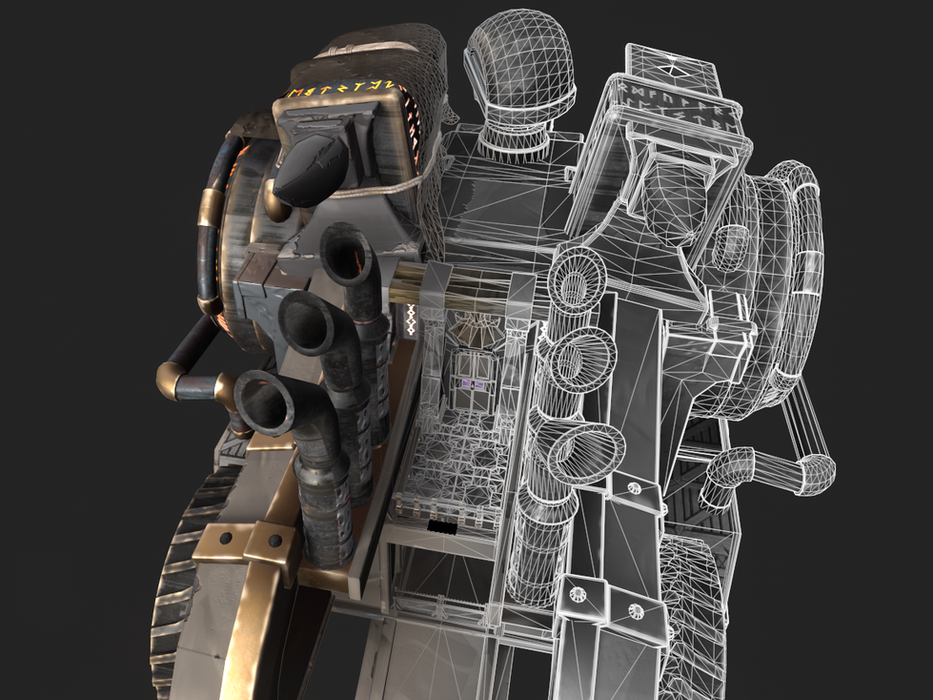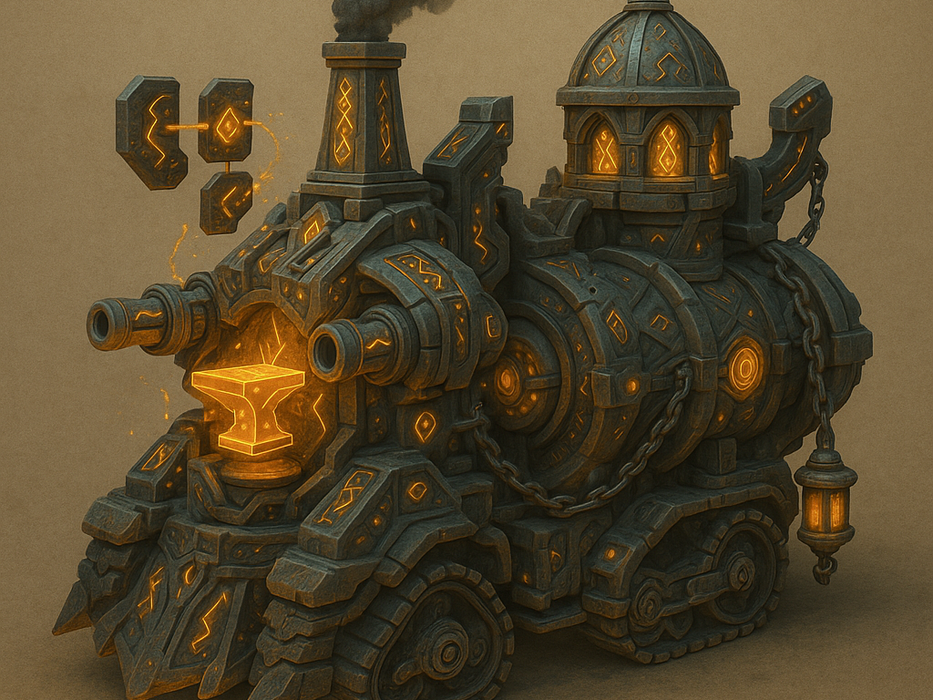
MOLGRATH'S ANVIL



BACKSTORY
Forged in the crucible halls beneath VaeBrukh, the siege vehicle Molgrath’s Anvil was a weapon of war; a moving forge-temple created to transport and protect the Ember Lexicon during the final years of the Fracture War. It was crafted by High Artificer Molgrath the Elder, a dwarven master rune-smith whose lineage once safeguarded the Heartglyph Anvils - the foundational forges of the First Dwarves.
Built with adamantine chassis bones and arc-welded runestone plating, the Anvil was animated not by beast or coal, but by a core-fragment of the Ember Lexicon itself - a piece that hums with bound fire-essence and ancient vow-sigils.
DESCRIPTION
Hard Surface Model - Siege Vehicle
A hulking dwarven forge-crawler crafted as a hero prop for fantasy RPGs and stylized cinematics. Designed for use in stylized or semi-realistic pipelines, Molgroth’s Anvil combines brutalist shape language, ancient rune-etched tech, and aggressive vertical exhaust to convey raw industrial power barely constrained by arcane tradition. This autonomous forge-unit serves both lore and gameplay, establishing a visual anchor for any dwarven stronghold or battlefield.
Total Poly Count: 64,746 (game-ready; sculpted in ZBrush at 700k+ high-poly for baking)
Render Engines: Substance Painter Iray (for wireframes) & Unreal Engine 5 (for rendering and in-world integration)
Breakdown:
-
Modeled in 3DS Max with iterative blockout, silhouette enhancement, and mid-poly edge definition
-
Baked in Substance Painter using optimized curvature/AO/position maps; no high-poly sculpt required
-
Custom smoke volumes created from mesh-based stylized forms and emissive-driven shader blending
-
Textured with layered metals, emissive runes, soot, scorches, and grime, stylized to balance believability and exaggeration
-
Exhausts, balcony, and runic turbines designed to support vertical storytelling and give direction to motion
-
Rigs built-in functionality: collapsing gangplank, throne compartment, and weapon port
Created as a solo hero prop to explore stylized worldbuilding and industrial fantasy aesthetics. This piece showcases integration of storytelling into every design beat — from soot-scorched pipe bends to dwarven glyph seals. Balanced for clarity, silhouette, and real-time engine optimization.
ROLE:
Solo project — modeled, UV’d, textured, baked, and rendered as a narrative-driven stylized hero asset
TOOLS:
3DS Max (mid-poly modeling), Substance Painter (masking, emissives, smart materials), Unreal Engine 5 (presentation render)
PURPOSE:
Hero prop for stylized fantasy RPG environments. Built to experiment with nanite, and to demonstrate high-level world cohesion, visual clarity at distance, and deep integration of prop storytelling within an industrial dwarven culture.
MODEL VIEWER TURNAROUND
CONCEPT
I want to design a fantasy siege vehicle that fits into the same world as Vae’Brukh and the Ember Lexicon — ancient, arcane, and dwarven-built, but with a distinct mechanical identity. Molgrath’s Anvil isn’t just a weapon of war; it’s a rolling forge, a mobile construct that smashes through frontlines while carrying deep industrial magic in its core.
It’s not elegant. It’s loud, overbuilt, and brutal. Every bolt, panel, and arcane seal should look like it was made to endure centuries of punishment. Function comes first, but the function is sacred — like a battering ram made by people who revere gears and flame.
REFERENCES
Visual Influence & Direction
Drawing from the following visual references:
CONCEPT
DESCRIPTION
Arcane-Powered Forge Core
The anvil is powered by an internal energy source — either molten magic, blue aether, or a bound elemental. It glows beneath thick plates, barely contained. The name isn’t symbolic — there’s literally a forge built into it.
Siege Chassis & Mobility
It moves, but it’s not fast. Treads, wheels, or enchanted stabilizers keep it grounded. I want to show weight and impact in the way the base is constructed — reinforced frame, massive suspension, armored underbelly.
Cannon-Mounted or Hammer-Like Weaponry
On the front, I imagine it either launches arcane projectiles or slams down a magical hammer/piston mechanism. It delivers blunt force damage and magical shockwaves — like a dwarven artillery golem.
Layered Armor Plating
Plates overlap like medieval tank armor. I want some of them cracked or scorched from past engagements. Exposed bolts, welded seams, and patchwork metal detail help tell the story of field repairs and centuries of use.
Sigils, Bindings, and Gears
Arcane glyphs are engraved into critical parts — containment rings, locking runes, binding plates. I mix mechanical with magical to keep it consistent with the world’s style: ancient tech powered by controlled magic.












